With contributions from industry thought leaders:
 Lauren Benton | General Manager, Back Market USA
Lauren Benton | General Manager, Back Market USA
Electronics is a great business to be in – so long as everything runs perfectly. On the surface, the fundamentals look great: high value per item, healthy markups/margins, and durable stock. However, ecommerce has distinct challenges for both electronics brands and multi-brand retailers. These can make it harder to achieve the full potential.
Marketplaces have a pivotal role in helping sellers build a broader customer base. Significant horizontal marketplaces such as Amazon, eBay, and Shopee can reach the broadest audiences. At the same time, local heroes like Bol., Mercado Libre, and Allegro can leverage their regional prominence to the advantage of cross-border and local merchants.
Combined, these marketplaces are responsible for a staggering volume of Consumer Electronics sales.
Despite this, it can be difficult for brands and technology innovators to get enough exposure. The market is becoming increasingly crowded with cheap, ‘no-brand’ competitors. This stiff competition makes it harder for new, high-quality brands to enter the market. It’s also tricky for established brands that want to maintain their market position and resist price erosion.
Retailers and distributors also find that there’s no shortage of competition from sellers offering cheap, disposable tech to an undiscerning public. Trends are cycling more rapidly than ever, and concerns about sustainability and the environmental impacts of electronics waste are starting to influence buyer behavior.
Savage competition
Retailers must meet the challenge of stiff competition while maintaining margins by reducing their returns rate and fighting depreciation via obsolete stock.
To recoup the significant capital invested in stock, retailers must keep up with rapidly cycling trends and maintain a high stock velocity – without cutting prices too hard.
The lowest price will always be the deciding factor for some customers - but not all of them. The profusion of cheap, low-quality products is not something to be feared by a brand or retailer that can offer high-quality or distinctive deals. Choice overload is a real problem for consumers, who find it hard to distinguish from thousands of near-identical offers.
Potential sales may be lost when a profusion of offers leads to confusion and frustration. Good quality service and peace of mind often mean more to the consumer than a sharp price.

Image 1. Renewed device marketplace Refurbed is cashing in on smart consumers who want a positive impact while saving money.
As a result, sellers who can distinguish themselves by offering the best quality, excellent service, and extended guarantee periods can attract a bigger catch from the pool of potential buyers. Marketplaces also play a role in guiding customers to the best products from the best sellers. This guidance ensures that customers get a product they’re happy with and that the seller gets the best price for their quality devices.
- Lauren Benton, General Manager, Back Market USA
Market Dynamics
As technology continues to evolve, the electronics industry is experiencing a strategic shift towards direct-to-consumer (D2C) and service-based business models. Although implementing D2C models has been challenging, digital business transformation is now making them more scalable and cost-effective.
Creating an online sales and service channel helps retain margins and allows for direct interaction with consumers, providing valuable first-party data. This data is crucial for driving innovation in products, loyalty programs, and personalized offers within an omnichannel framework.
Empowering Brands with D2C Models
The D2C approach offers brands greater control over supply chains, customer experiences, and pricing. The rise of marketplaces and partnerships has significantly contributed to this transformation.
Ecommerce no longer requires substantial investments in complex backend systems, thanks to out-of-the-box solutions and marketplace collaborations. Successful electronics brands are utilizing these marketplaces to sell refurbished or “pre-loved” goods and are even exploring peer-to-peer sales models with an approved status.
The success of D2C channels is also prompting a reevaluation of physical retail. Brands are transitioning to branded Experience Centers and pop-up stores, replacing traditional retail spaces with immersive, technology-driven experiences. They are using augmented reality (AR) and virtual reality (VR) to showcase products that align with their brand visions. This shift opens up exciting possibilities, providing alternatives to the conventional big-box electronics retail model.
Positive environmental impacts
Probably the most significant trend in electronics today is the issue of sustainability and e-waste – particularly for consumer electronics which are replaced and discarded at an alarming rate. Consumer electronics are essential for our modern lives, but we still need to get better at how we master the lifecycle of these products.
Extending the lifespan of products will likely involve enhancing their upgradability and recyclability, as well as providing more support for second and third ownership cycles. This shift offers brands opportunities to deliver value-added products and services to the pre-owned market. Ultimately, achieving long-term sustainability requires scalable, profitable, and sustainable solutions, which remains a significant challenge.
Consumers are actively contributing to the sustainability movement, leading to a significant increase in the market for refurbished and used electronics. According to Simon Kucher and Partners, consumers see themselves as the #1 actor responsible for bringing positive environmental change. Around 50% of consumers see sustainability as a top 5 value driver, demonstrating that it is desired and worth paying for.
Figure 2. Pre-owned devices provide a steady supply of revenue and benefit the environment.
The rise in global inflation and tighter consumer budgets are also fueling the growth of the second-hand market. In response, retailers and manufacturers are competing to provide consumers with better value for their old devices to encourage sales.
-Sarafina Dalipi, Refurbed
More brands tackle this issue head-on by offering their own expert-refurbished devices directly or via specialist marketplaces. Customers love the reassurance that their renewed device is refurbished by the actual brand that made it, which helps to control the market position and reputation of that brand’s refurbished items.
Many retailers and specialist companies are also jumping on this trend. They’re generating new stock of high-quality renewed devices using the vast supplies of used devices harvested from corporations and trade-ins. This business model enables them to offer a steady supply of renewed devices at prices that even the most ruthless discounters would struggle to match. Consumers keen to make a positive environmental impact now have more options.
Uncertainty and Disruption
Electronics are a big investment for all parties concerned. There are significant development and procurement costs for brands and technology innovators, and retailers have substantial capital in bulky, high-value items. Materials, components, and finished devices are shipped across huge distances and international borders at every stage of the process. If everything runs smoothly, then there’s nothing to worry about. However, this scenario is a distant memory for most of us.
Supply chain disruptions have a massive impact. Retailers worry if/when their shipments are delayed, potentially missing critical sales seasons, which can also affect the brands. Manufacturers, meanwhile, are constantly struggling with finding chips and other critical components. Given the current supply chain situation and the ongoing geopolitical tensions, any business operating in this area must maintain a high level of agility.
Renewed devices are helping to reduce the pressure on the ‘new devices’ market and the supply crunch. This phenomenon is also helping to build a circular economy, which would go a long way to resolving the supply chain problems we have today.
Another key tactic, however, is platform-based e-procurement, which helps brands to become more agile in their production capabilities. Specialized B2B platforms for technical sourcing, like Conrad, are helping to ensure a global and regional supply network for manufacturers by consolidating their supplier network into a single e-procurement platform. In addition to the well-known public marketplace, Conrad offers its Partners exclusive access to private marketplaces. These are integrated into the e-procurement solutions of larger customers with differentiated catalogs and pricing.
- Rado Svec, Vice President Platform at Conrad Electronic
With a single platform, brands and manufacturers can secure a reliable supply of components from wherever they are in stock without needing to approach each supplier separately. This also reduces the costs of finding parts and components, especially c-parts (disproportionately expensive to the resource).
Retailers can gain agility by opening up their business model to include various customer types, including high-volume B2B customers.
- Rado Svec, Vice President Platform at Conrad Electronic
Moreover, marketplaces help sellers make the most of a supply crunch by ensuring that their pricing reflects the overall availability on the market and reaches customers at the points where goods are being sold.
Technological Innovations
Several technological innovations are set to change the consumer electronics industry in major ways. AI and machine learning, the Internet of Things, and 5G are all things to watch as their development continues.
AI and Machine Learning
While 2023 saw companies cautiously experimenting with AI, the upcoming year is poised for more profound and extensive adoption. AI’s capability to analyze vast datasets enables the creation of highly personalized user experiences in real-time.
Connected devices, rich with data, provide deep insights into user habits and preferences. This data will drive targeted promotions, marketing campaigns, sales strategies, and predictive market trends, ushering in an era of extreme personalization.
The Internet of Things
The Internet of Things is changing the way that consumers interact with electronics. The Internet of Things (IoT) involves connecting everyday items, such as appliances and gadgets, to the internet, enabling them to communicate and perform additional functions.
In 2022, the IoT market was valued at approximately $1.3 trillion and is projected to grow to $3.3 trillion by 2030, with a compound annual growth rate (CAGR) of 12.4%. A practical example of IoT is using voice commands with devices like Alexa or Google Assistant to control home lighting, temperature, or security systems.
Companies like Google and Amazon have developed electronic devices that allow users to manage various home devices using voice commands.
5G Development
Soon, the market will finally see the much-anticipated impact of 5G technology and edge computing. The high-speed, low-latency capabilities of 5G networks will open up numerous opportunities, particularly with the rise of products that integrate physical and digital elements to enhance user experiences.
The advancement of more accessible edge computing, which allows these products to process data locally, combined with the progress in smart devices, is driving real-time data processing. This development enhances scalability and improves consumer data security.
Conclusion
Competition is fierce when it comes to Consumer Electronics. Brands and merchants that differentiate their offers in this crowded market will win a greater market share and reach new pools of potential customers.
Today, ethical considerations are a major driving influence on consumer behavior. Consumers routinely make purchases based on environmental and sustainability issues so it makes good sense to look at ways to meet this demand. Marketplaces like Refurbed and Back Market are the perfect match for both sellers and consumers. As part of an intelligent marketplace strategy, niche marketplaces can provide unique value to sellers by helping them reach new consumer groups, including the often-neglected business consumers of electronics products.
ChannelEngine facilitates the sale of over 3 million products from 1,500 brands on 100+ marketplaces. Learn more about our local and international marketplaces to connect your store to millions of consumers – and grow globally. Contact us for more information!








